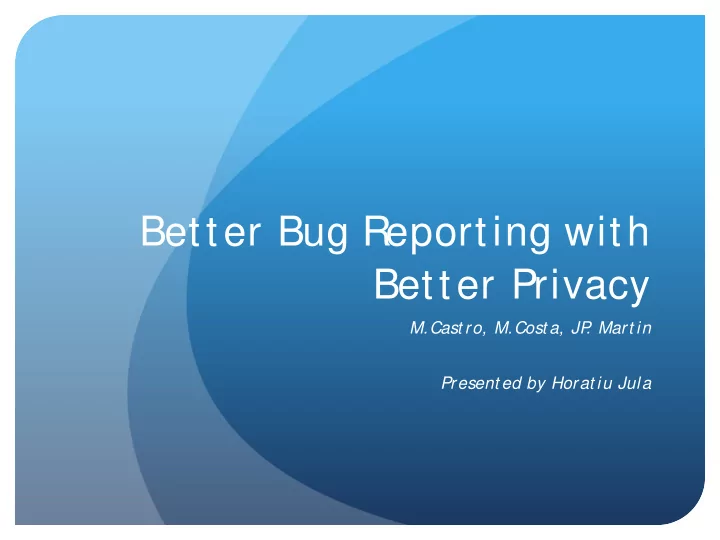

Better Bug Reporting with Better Privacy M.Cast ro, M.Cost a, JP . Mart in Present ed by Horat iu Jula
Imagine a crash
Report the crash
Bug reporting today Stack trace, memory dumps May be insufficient S olution: send path conditions Application-specific extras, failure-inducing document May reveal private information Users may not know if what they send contains private data S olution: send a new document, without private data (if possible), that reveals the same bug
The approach Error detection in normal execution Input log Replay bug in background Instruction-level trace ymbolically execute the trace Path conditions that hold for the bad input and cause S the bug S olve the constraints to get new inputs that satisfy the path conditions #bits revealed from the original inputs
Example int ProcessMessage(int sock, char *msg) { char url[20]; char host[20]; int i=0; if (msg[0] != ’ G’ | | msg[1] != ’ E’ | | msg[2] != ’ T’ | | msg[3] != ’ ’ ) return -1; msg = msg+4; while (*msg != ’ \n’ && *msg != ’ ’ ) { url[i++] = *msg++; } Buffer overflow, for i >= 20 url[i] = 0; GetHost(msg, host); return ProcessGet(sock, url, host); }
Compute path conditions int ProcessMessage(int sock, char *msg) { S tate: char url[20]; *msg = b0,b1,b2,… char host[20]; i = 0 int i=0; if (msg[0] != ’ G’ | | msg[1] != ’ E’ | | msg[2] != ’ T’ | | msg[3] != ’ ’ ) return -1; Conditions: msg = msg+4; while (*msg != ’ \n’ && *msg != ’ ’ ) { url[i++] = *msg++; } url[i] = 0; GetHost(msg, host); return ProcessGet(sock, url, host); }
Compute path conditions int ProcessMessage(int sock, char *msg) { S tate: char url[20]; *msg = b0,b1,b2,… char host[20]; i = 0 int i=0; if (msg[0] != ’ G’ | | msg[1] != ’ E’ | | msg[2] != ’ T’ | | msg[3] != ’ ’ ) return -1; Conditions: msg = msg+4; b0=‘ G’ / \ b1=‘ E’ / \ while (*msg != ’ \n’ && *msg != ’ ’ ) { b2=‘ T’ / \ b3=‘ ’ url[i++] = *msg++; } url[i] = 0; GetHost(msg, host); return ProcessGet(sock, url, host); }
Compute path conditions int ProcessMessage(int sock, char *msg) { S tate: char url[20]; *msg = b4,b5,b6,… char host[20]; i = 0 int i=0; if (msg[0] != ’ G’ | | msg[1] != ’ E’ | | msg[2] != ’ T’ | | msg[3] != ’ ’ ) return -1; Conditions: msg = msg+4; b0=‘ G’ / \ b1=‘ E’ / \ while (*msg != ’ \n’ && *msg != ’ ’ ) { b2=‘ T’ / \ b3=‘ ’ url[i++] = *msg++; } url[i] = 0; GetHost(msg, host); return ProcessGet(sock, url, host); }
Compute path conditions int ProcessMessage(int sock, char *msg) { S tate: char url[20]; *msg = b20,b21,b22,… char host[20]; *url = b4,b5,b6,… int i=0; i = 20 if (msg[0] != ’ G’ | | msg[1] != ’ E’ | | msg[2] != ’ T’ | | msg[3] != ’ ’ ) return -1; Conditions: msg = msg+4; b0=‘ G’ / \ b1=‘ E’ / \ while (*msg != ’ \n’ && *msg != ’ ’ ) { b2=‘ T’ / \ b3=‘ ’ / \ url[i++] = *msg++; b4 != ‘ \n’ / \ b4 != ‘ ‘ / \ } … url[i] = 0; b20 != ‘ \n’ / \ b20 != ‘ ‘ GetHost(msg, host); return ProcessGet(sock, url, host); }
S ummary Symbolic execution reveals the constraints under which a bug can occur Solving gives new inputs that trigger the same bug For our example Memory dumps may reveal private information New input: ‘ GET ................’ (‘ .’ represents byte value 0) Only 4 bytes were relevant for the bug and had to be revealed
Evaluation Efficient technique Generates reports quickly (<2min) Provides good privacy Reveals very little of the original document (<15% )
Related work Vigilante (SOSP 2005) Compute path conditions for an exploit and inline them into the application, as a filter for protecting the application against the exploit Bouncer (SOSP 2007) Extends Vigilante with S implifying the path conditions Learning new exploits by removing/ duplicating bytes in the original exploit New path conditions are derived for each new exploit The final filter is a disj unction of the path conditions of the exploits
Recommend
More recommend